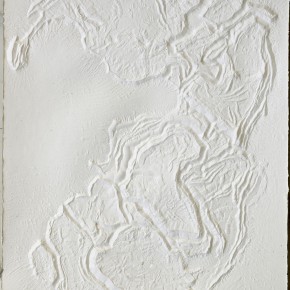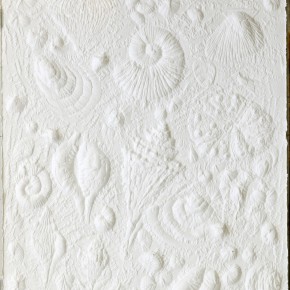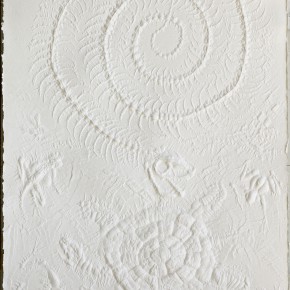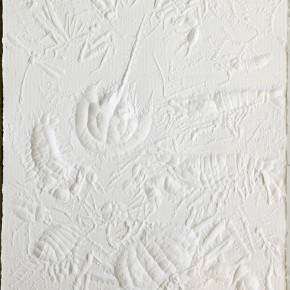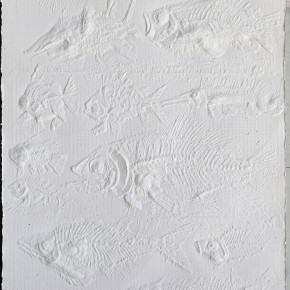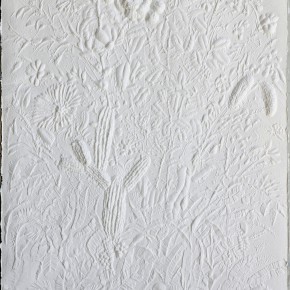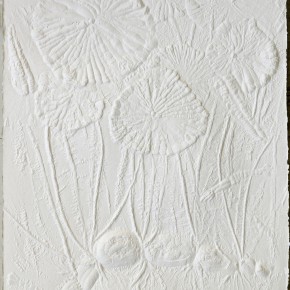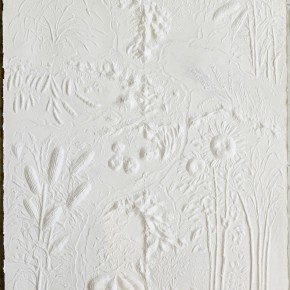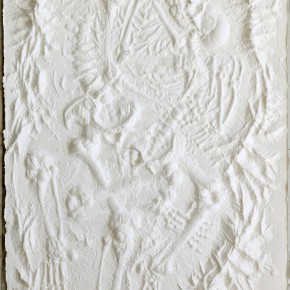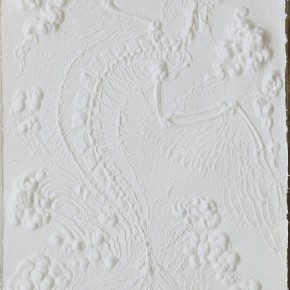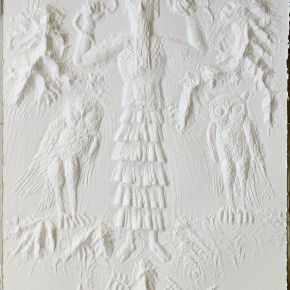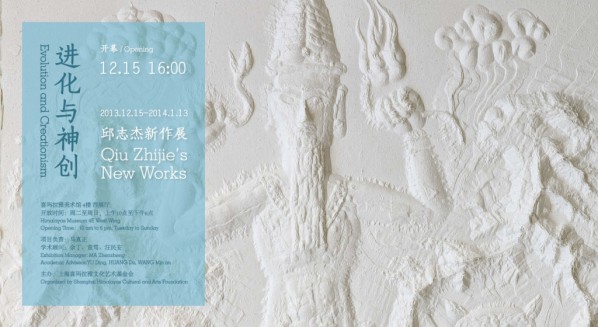
It is the last but not least exhibition in 2013 of the seven solo exhibitions of new works by Qiu Zhijie , in the series of studio productions, Qiu Zhijie simultaneously promotes two themes which intensely conflict with each other: paper relief “Evolution” series reflects “mystery stories” and “archaeological” landscapes in the typical form of Qiu Zhijie. The series of works are exhibited chronologically, starting from ancient Pan Gu continent continuing to the invention of agriculture. The screens are filled with ancient fossil specimens, mountains, and fragments of implements, which seem to just be excavated from the earth and are mysteries waiting to be explored. Pure texture of white cotton paper makes the warmth and strangeness coexist in the shapes.
In the huge ink paintings “Theogony” series, spatial relations replace the axis of time, gods’ status from various civilizations in the world are listed one by one. Qiu Zhijie breaks the effect that ink leaves on the last day produced by using a big flat brush, which is a traditional ink technique, applied in a rough heroic way to absorb the nutrition of Western realism sketching. Although these gods are huge, they carry a human temperament like the Renaissance. It makes the audience guess the idea of the artist, in the debate on the theories of evolution and creation, the artist actually disapproves of the latter.
Like all creations of Qiu Zhijie, we see a sharp political issue hidden in the rich and complicated images and cultural sense in the exhibition again. It even vaguely points to the forefront on a genetically modified (gm) discussion.
The debate of intelligent design - creation and evolution is so far more than a scientific issue, but also a political issue. The following information is from wikipedia:
Intelligent design (ID) is a form of creation presented by its proponents as a theory that "certain features of the universe and of living things are best explained by an intelligent cause, not an undirected process such as natural selection." It is a version of the theological argument from design for the existence of God presented as "an evidence-based scientific theory about life's origins" rather than "a religious-based idea".
The leading proponents of this version of the argument are associated with the Discovery Institute, a politically conservative think tank based in the United States, that believes the designer to be the Christian deity. Their concepts of irreducible complexity and specified complexity propose that certain biological features are too complex to be the result of natural processes, and proponents therefore conclude that these features are evidence of design. The scientific community considers intelligent design a pseudoscience because it lacks empirical support and offers no tenable hypotheses. Detailed scientific examination has rebutted the claims that evolutionary explanations are inadequate, and this premise of intelligent design, that evidence against evolution constitutes evidence for design which has been criticized as a false dichotomy. From the outset, ID proponents have sought to overturn the methodological naturalism inherent in modern science, proposing that it be replaced by "theistic realism" or "theistic science" in which ID presents a broadly theistic understanding of nature.
The intelligent design movement was developed by a group of American creatives who revised their argument in the creation–evolution controversy to circumvent court rulings such as the United States Supreme Court's Edwards v. Aguillard decision, which barred the teaching of creation science in public schools on the grounds of breaching the separation of church and state. The first publication of the phrase intelligent design, in its present use as an alternative term for creation and occurred in Of Pandas and People, a 1989 textbook intended for high school biology classes. From the mid-1990s, intelligent design proponents were supported by the Discovery Institute, which, together with its Center for Science and Culture, planned and funded the "intelligent design movement". They advocated inclusion of intelligent design in public school biology curricula, leading to the 2005 Kitzmiller v. Dover Area School District trial, where U.S. District Judge John E. Jones III ruled that intelligent design is not science, that it "cannot uncouple itself from its creative, and thus religious, antecedents", and that the school district's promotion of it therefore violated the Establishment Clause of the First Amendment to the U.S. Constitution.
About the exhibition
Duration: December 15, 2013 - January 13, 2014
Opening Ceremony: 16:00 on December 15, 2013
Venue: the 4th floor of the Shanghai Himalayan Museum West Wing
Host: Shanghai Himalayan Culture and Arts Foundation
Exhibition Manager: Ma Zhenzheng
Academic Advisers: Yu Ding, Huang Du, Wang Min’an
Photo Courtesy of the artist and ZENDAI ART, text translated by Chen Peihua and edited by Sue/CAFA ART INFO.


